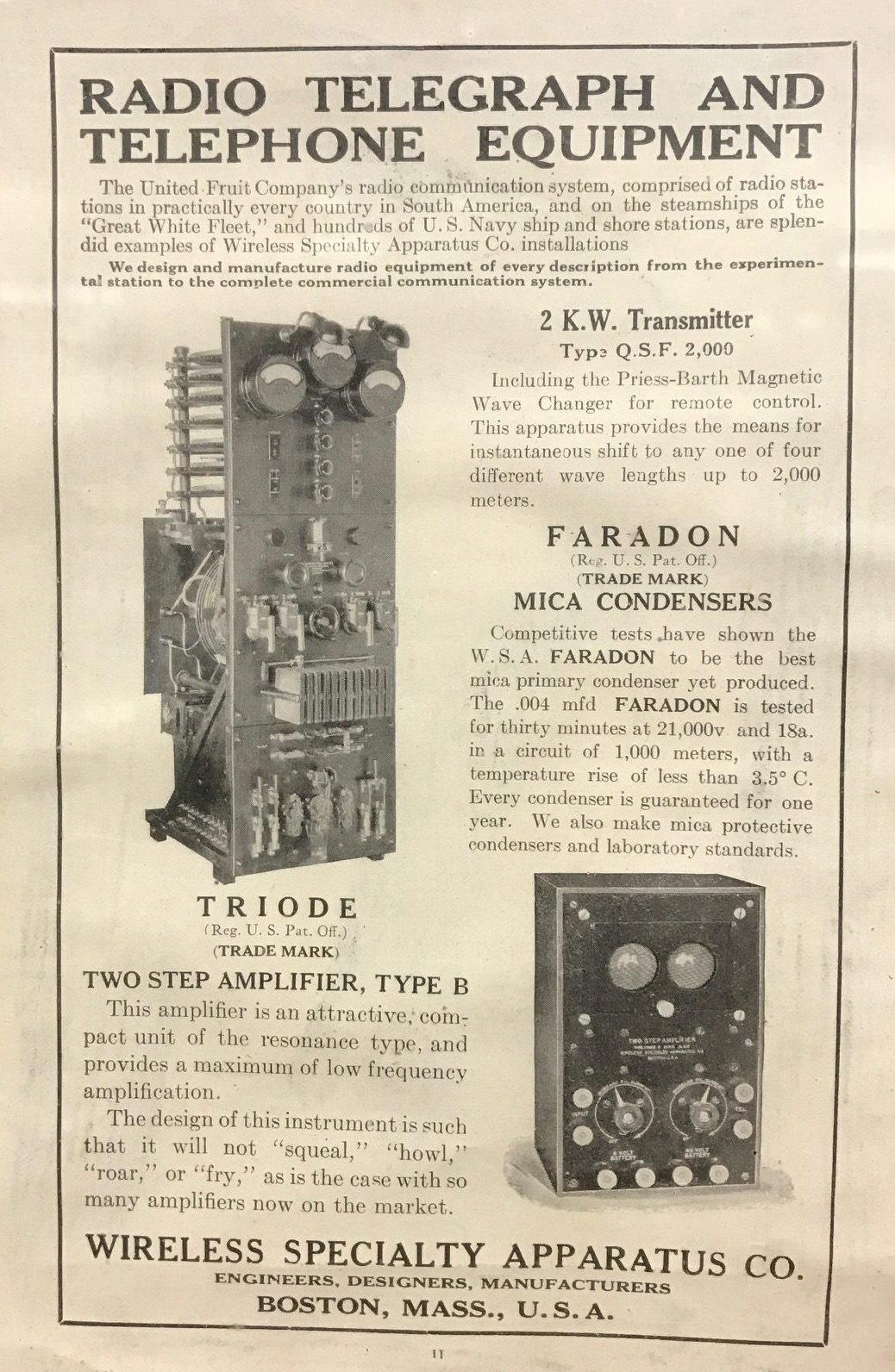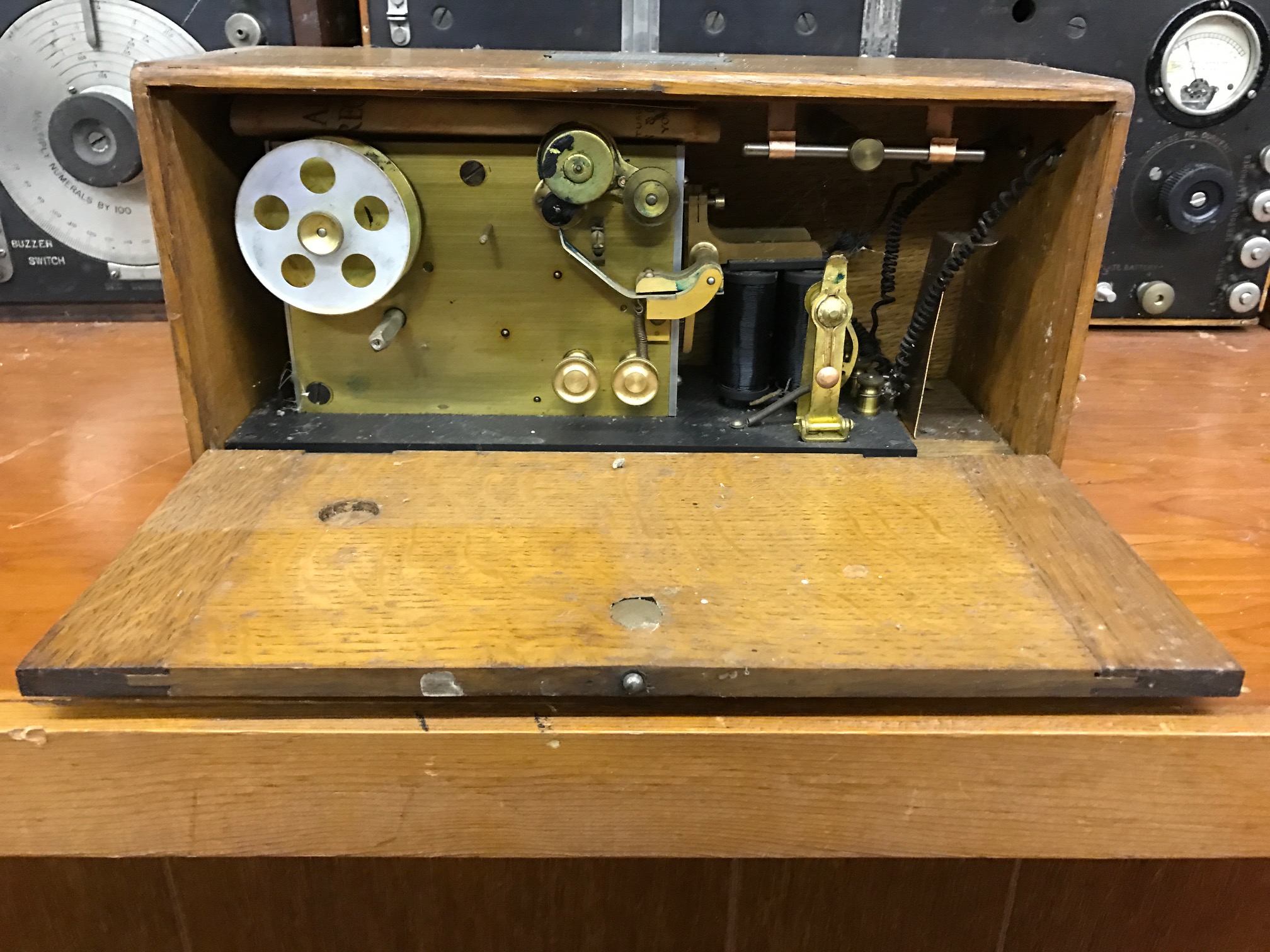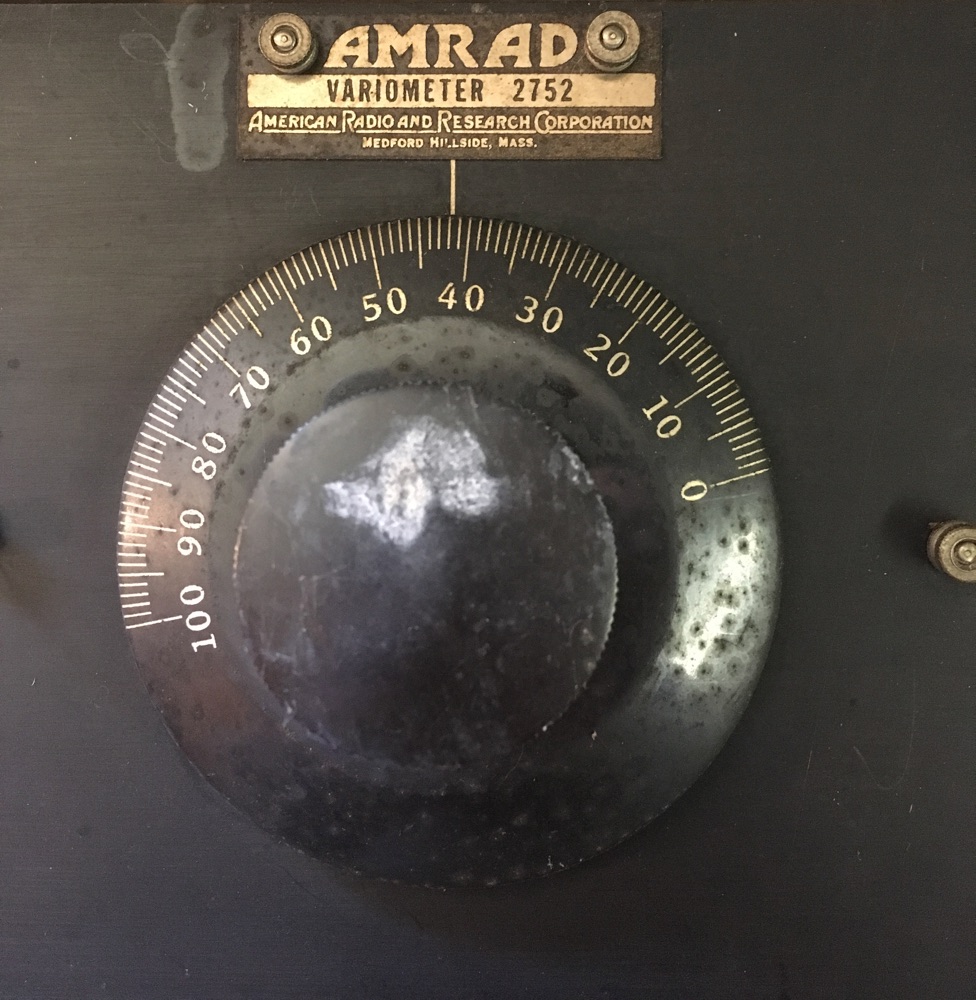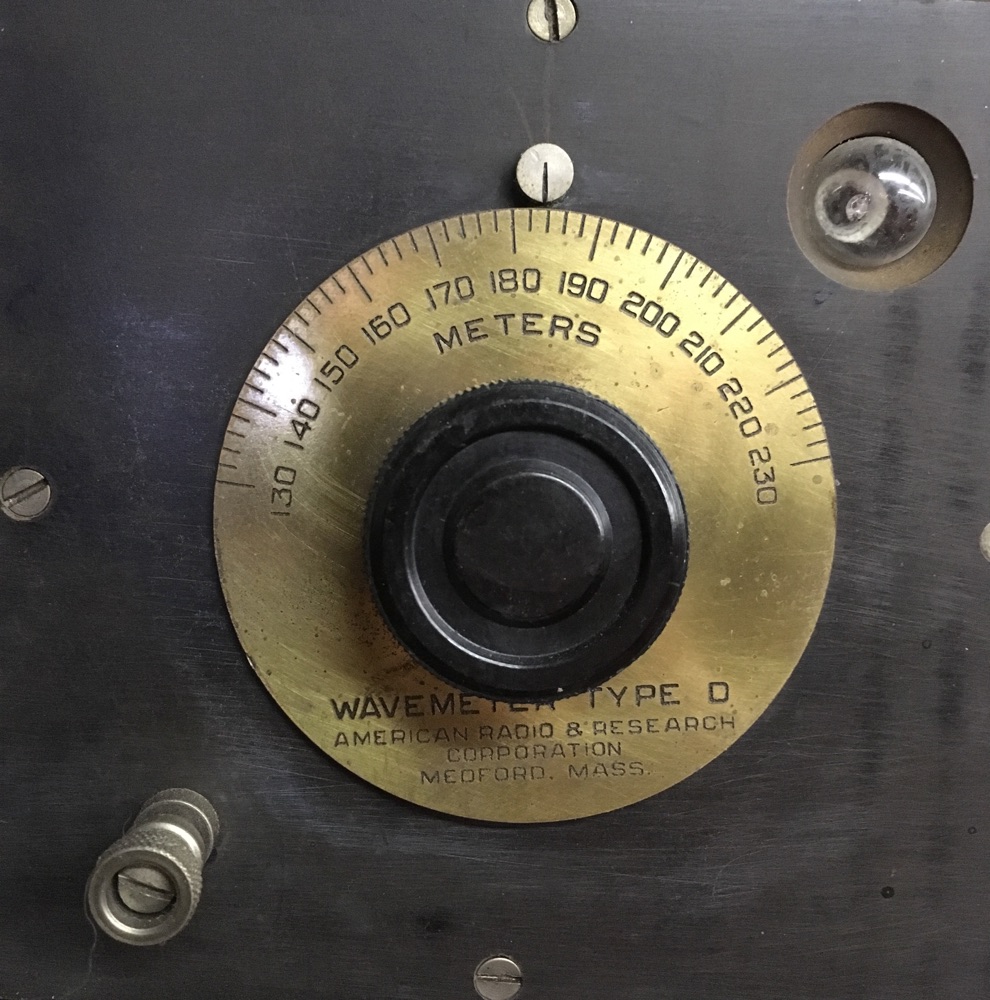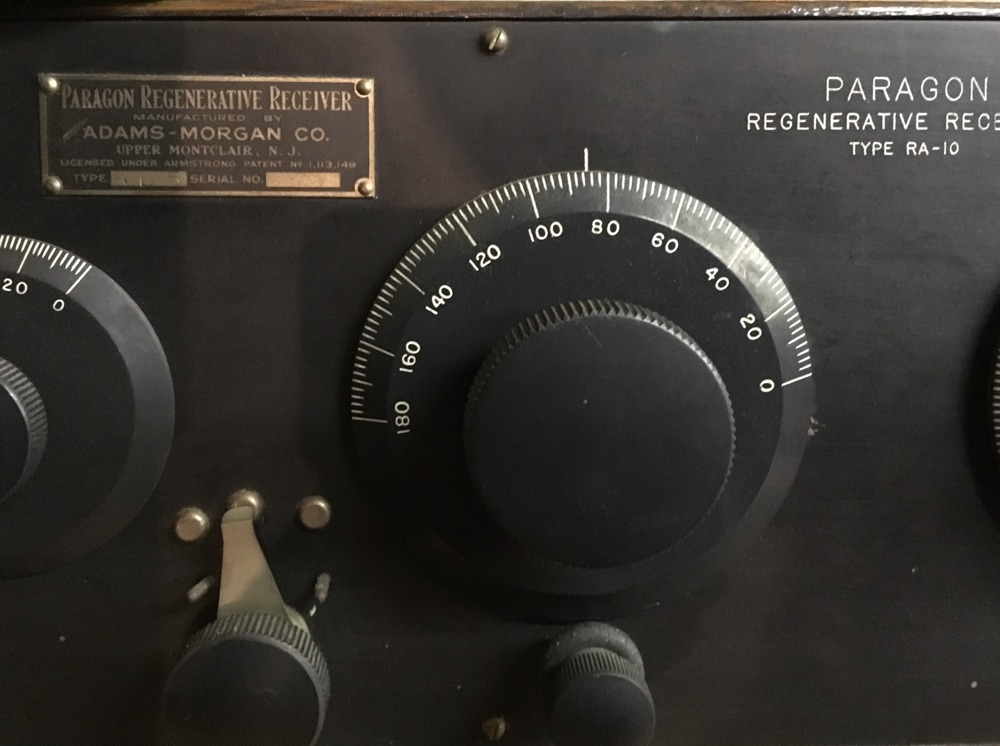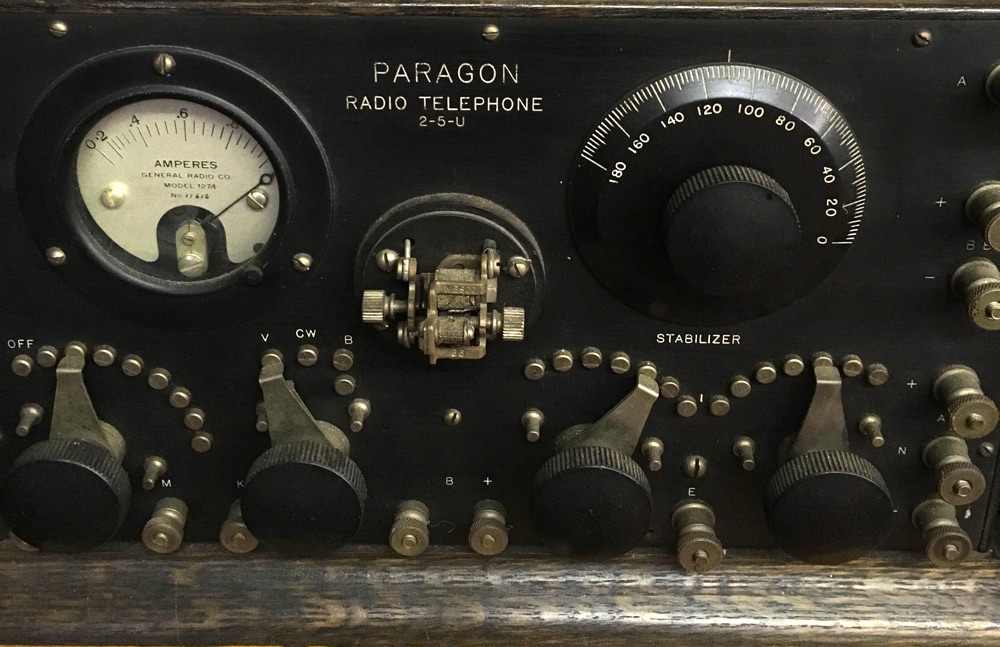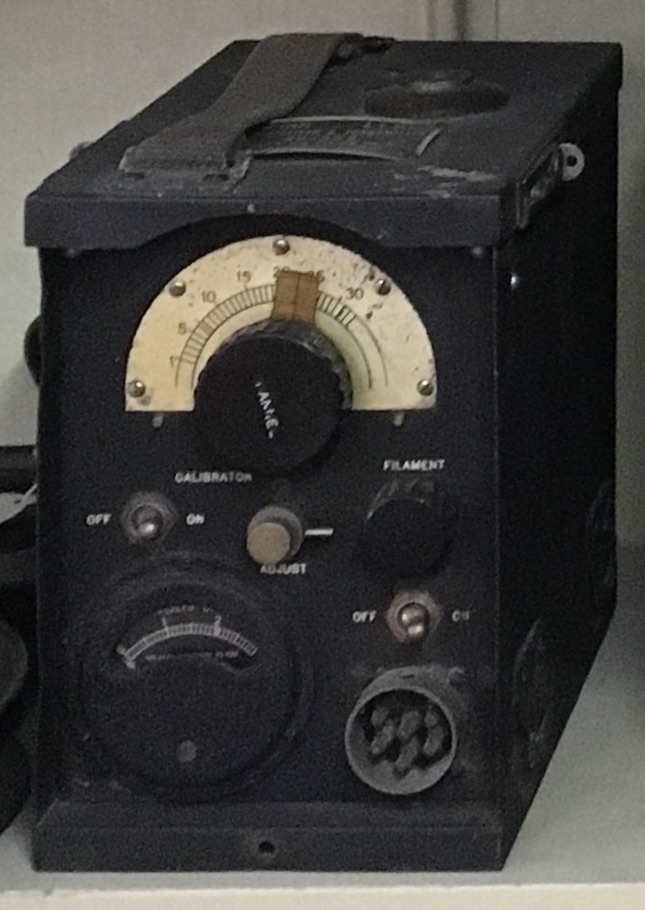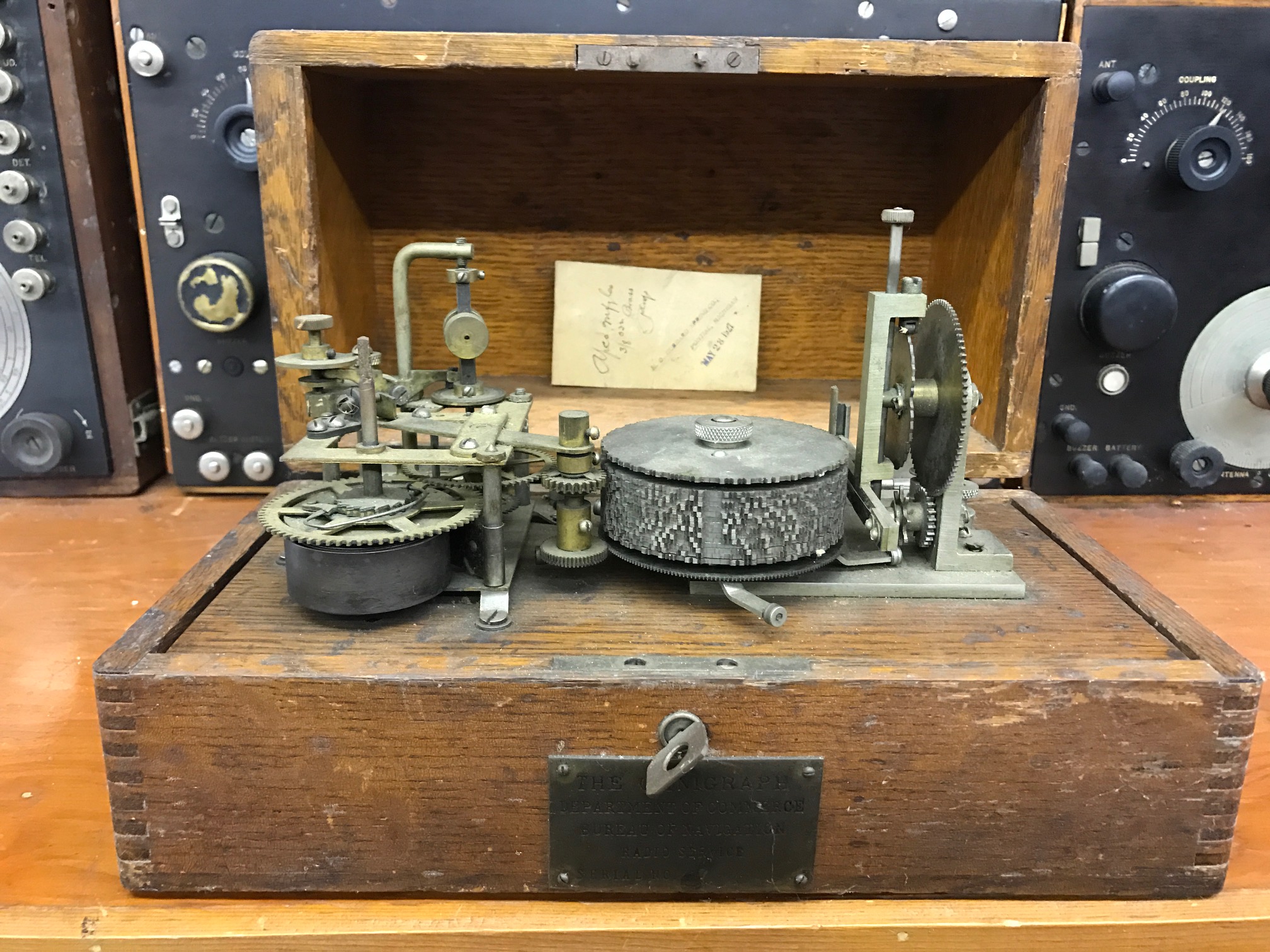Wireless
1930s Crystal Oscillator Transmitter #1
Gil Johnson, W1DZ, designed Crystal Controlled CW transmitter from the 1930s. →
1930s Frankenstein Transmitter
This is the Ca. 1930 CW Transmitter in the NEWSM collection. We refer to it as the Frankenstein transmitter. →
1930s George Grammer Designed TNT (Tuned-Not-Tuned) Transmitter #1
George Grammer designed Single Control CW transmitter based on the December 1929 article in QST magazine. →
1930s George Grammer Designed TNT (Tuned-Not-Tuned) Transmitter #2
George Grammer designed Single Control CW transmitter based on the December 1929 article in QST magazine. →
1930s George Grammer Designed TNT (Tuned-Not-Tuned) Transmitter #3
This is the third Ca. 1934 TNT CW Transmitter in the NEWSM collection. Please see the George Grammer Designed TNT (Tuned-Not-Tuned) Transmitter #1 for design details and reference material. This TNT Transmitter was made by an unknown home builder. As with TNT #1, it is built according to the plans in the December 1929 issue of … Continue reading "1930s George Grammer Designed TNT (Tuned-Not-Tuned) Transmitter #3" →
1930s TPTG (Tuned-Plate Tuned-Grid) Transmitter #1
Tuned-Plate Tuned-Grid CW transmitter similar to the design in the December 1929 article in QST magazine. →
1930s TPTG (Tuned-Plate Tuned-Grid) Transmitter #2
This is a Ca. 1930 TPTG CW Transmitter in the NEWSM collection. →
5 Band Communication Receiver built by Merril Budlong W1QLD
Atwater Kent Model 10A 4340 Radio #2
This is the original version of the Model 10A 4340 “breadboard” AM radio. The changes from the earlier designs include replacing the Variometers with coils and adjustable capacitors. This was Atwater Kent’s first really successful radio to use a fixed inductor and a variable capacitor for tuning, after the short lived Radiodyne. This one has … Continue reading "Atwater Kent Model 10A 4340 Radio #2" →
Ad for Radio Telegraph and Telephone Equipment
Aero Morse Recorder
Aeroplane Antenna Reel. Type RL-2
Two winding reels for antenna wire. →
Airborne Radio Equipment AN/ART-13
Airplane Radio Receiver, US Army Signal Corps, Type S.C.R. 59
Airplane Radio Telegraph Transmitting Set Box. Type BC-15A
Made for U. S. Army Signal Corps. →
All-Test Instrument Resistance
American Military Radio Collection
Amplifier Type CW-926
Patented in the U.S.A. July 14 '14 Mar. 2 '15 2 pats. Patents Applied For →
Amrad Variometer 2752
Amrad Wavemeter Type D
Antenna AN-131-A
Antenna insulators (2)
Labelled “Brown Beezer 6-7-87” →
Apco Manufacturing Co., Apco Twin Tube
Artmann & Baun A. G. Frankfurt A/M.
Atwater Kent Model 10A 4340 Radio #1
This Atwater Kent Model 10A 4340 Breadboard radio was introduced on May 29, 1924. →
Atwater Kent Model 10A 4340 Radio #3
This is the original version of the Model 10A 4340 “breadboard” AM radio. The changes from the earlier designs include replacing the Variometers with coils and adjustable capacitors. This was Atwater Kent’s first really successful radio to use a fixed inductor and a variable capacitor for tuning, after the short lived Radiodyne. This one has … Continue reading "Atwater Kent Model 10A 4340 Radio #3" →
Atwater Kent Model 10B 4550 Radio
This Atwater Kent Model 10B 4550 Breadboard radio was introduced about 1924. →
Atwater Kent Model 10C 4700 Radio #1
This Atwater Kent Model 10C 4700 Breadboard radio was introduced on May 29, 1924. →
Atwater Kent Model 10C 4700 Radio #2
This is an improved version of the original Model 10 “breadboard AM radio. The changes from the earlier version include eliminating the potentiometer that controlled RF amplifier grid bias and replacing it with an 800 Ohm damper resistor, and eliminating the bypass capacitors on the RF amplifier filaments. The set uses two 201A tubes for … Continue reading "Atwater Kent Model 10C 4700 Radio #2" →
Atwater Kent Model 30 radio
Atwater Kent model 30 receiver in Pooley model 1600 wood floor-model cabinet. →
Atwater Kent Model 42 radio
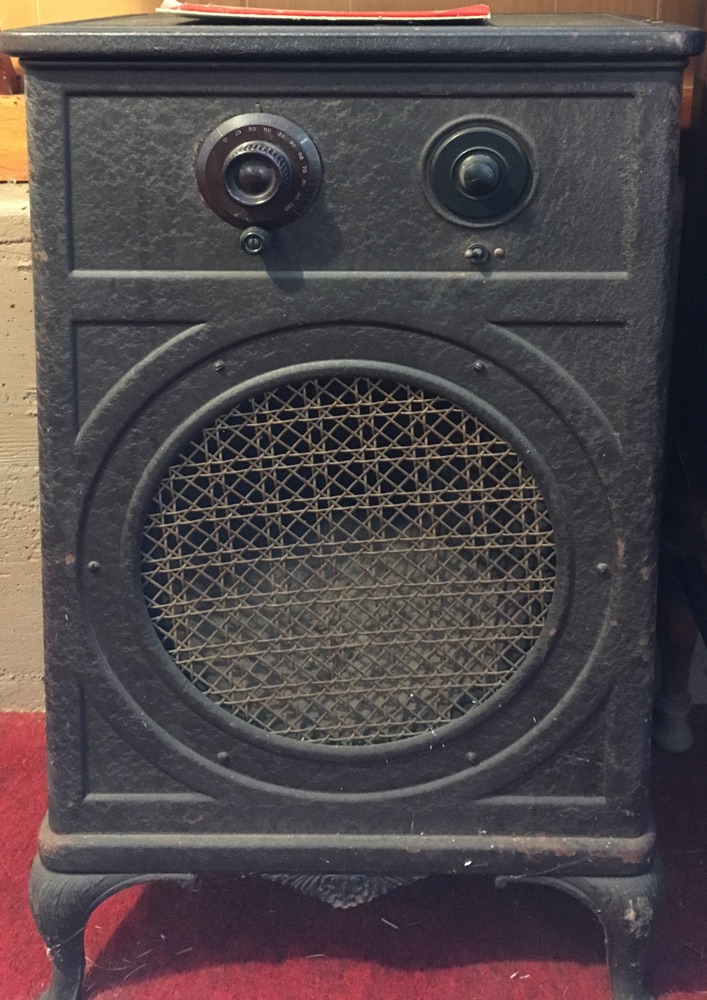 Atwater Kent model 42 radio receiver in floor model metal cabinet with large speaker. →
Atwater Kent model 42 radio receiver in floor model metal cabinet with large speaker. → Atwater Kent Model 55C Radio in Kiel Table
This 1929 radio was produced by the Atwater Kent (AK) company of Philadelphia, Pennsylvania. At first look it is not apparent that it is a radio. →
Atwater Kent Model 9C 4660 Radio
This is an improved version of the original Model 9 “breadboard AM radio. The changes from the earlier version include replacing the Variometer with a coil and an adjustable capacitor, and removing a potentiometer. The set uses one 201A tube for the Radio Frequency section, a 200 tube for the Detector, and two 201A tubes … Continue reading "Atwater Kent Model 9C 4660 Radio" →
Atwater Kent Model E radio
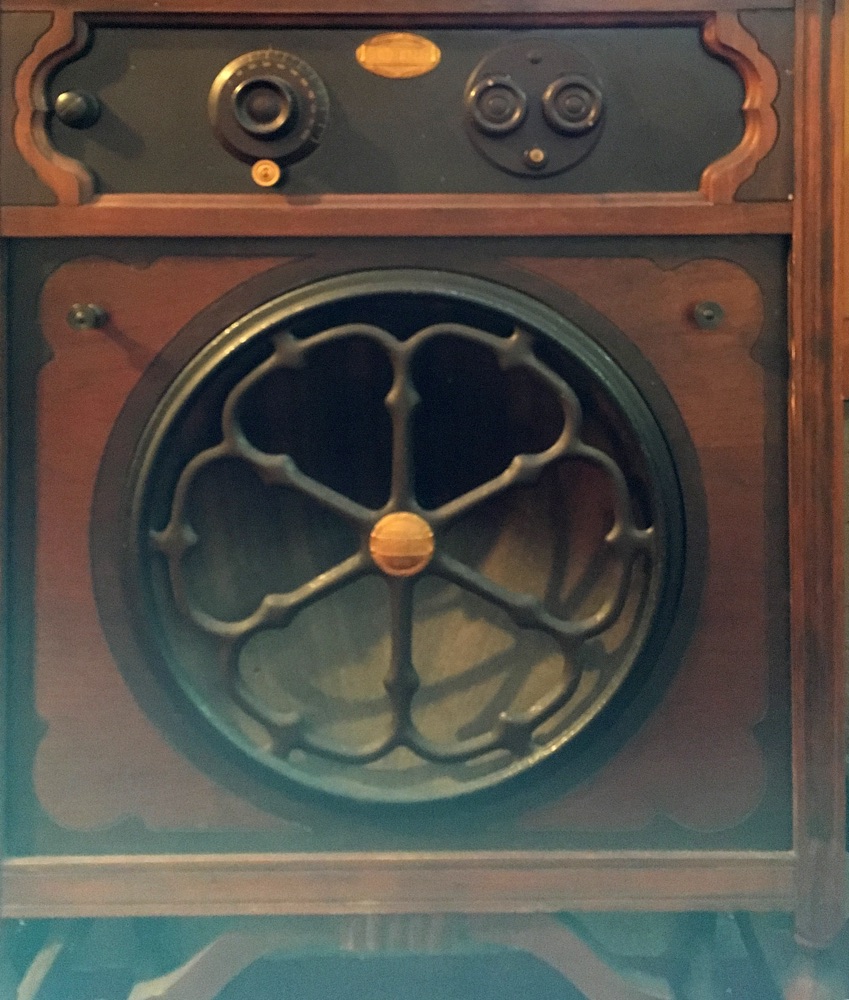 Atwater Kent model 33 receiver and loudspeaker in Pooley floor-model wood cabinet. →
Atwater Kent model 33 receiver and loudspeaker in Pooley floor-model wood cabinet. → Audibility Meter Type 164B
Audibility Meter Type CR836
Use Wireless Specialty Adjustable Telephone No. CR835 with this Meter. Do not use Series Telephone with this Meter →
Audion Control Box SE-1071
Made for Navy Sept (BU. S. E.) →
Bendix Transmitter T-100
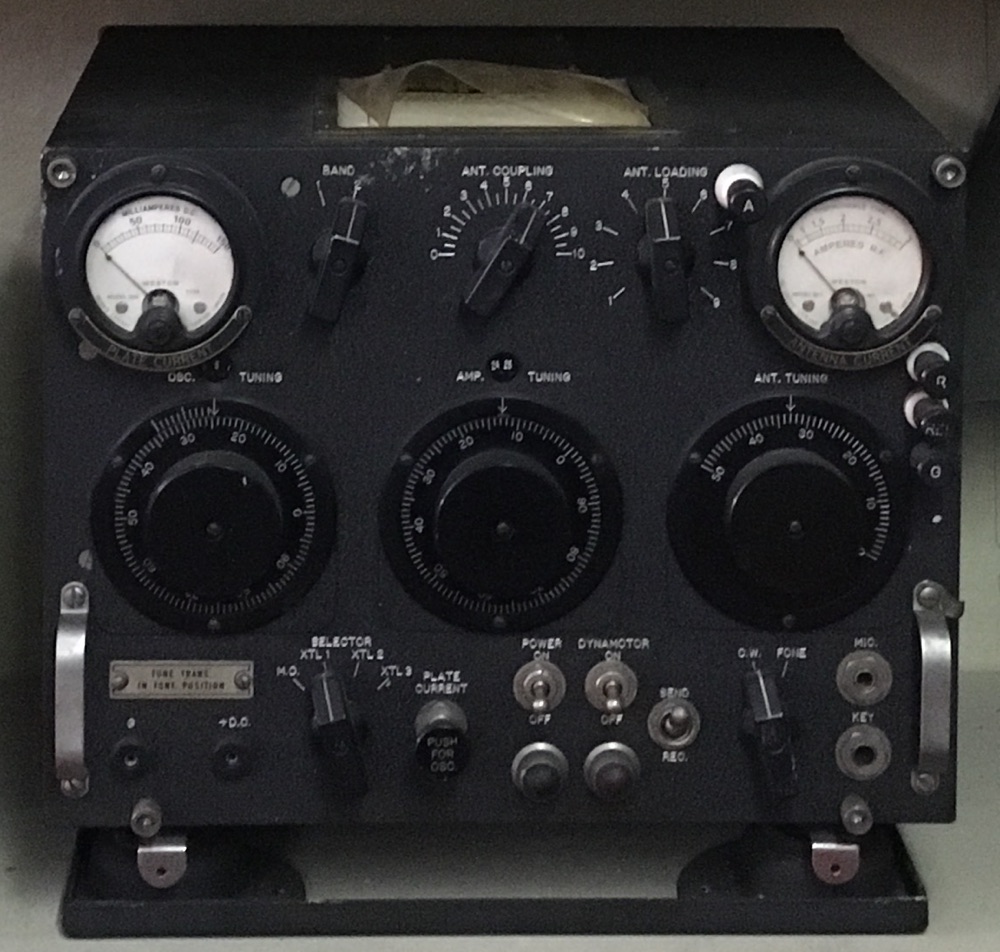 Built for the U. S. Coast Guard. →
Built for the U. S. Coast Guard. → Box of 4 Tubes, Raytheon Type B-H
Box of Plug In Coils
Boy Scouts of America key & sounder
Key, sounder and battery holder in brown plastic case. Accompanying brochure titled “Introduction to International Morse Code”. →
Bremer-Tully Counterphase Six
Bremer-Tully was know for making high quality radio components, radio kits, and complete radios. →
Buzzer on Board
C-87/ART-13 Transmitter Switch Box, US Navy
Calibration Headset, Frequency Meter BC-221-AU, BC-221-AK
Ce Co Type 227 radio tube
Chest Plate Microphone (Stand)
Chest Plate Micrphone
Collins 75A-4A Communications Receiver
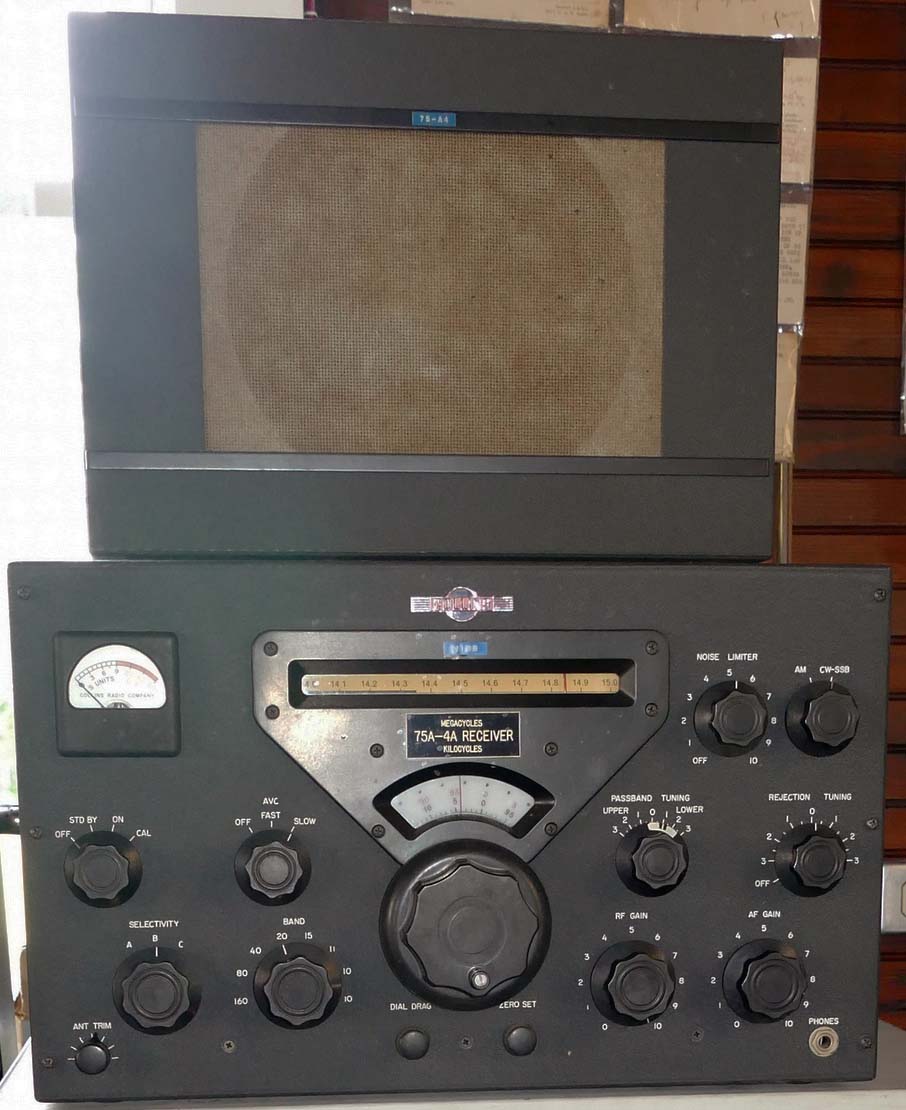 The Collins model 75A-4 was the last in the 75A series (-1, -2, -3, -4) that spanned the years 1945-1958. →
The Collins model 75A-4 was the last in the 75A series (-1, -2, -3, -4) that spanned the years 1945-1958. → Cow Sound Novelity
Cracraft-Leigh telephone
Handcranked wall-mount telephone with wood cabinet. →
Crystal Radio Collection
A Crystal Radio is one of the simplest forms of an AM radio and was introduced more than 100 years ago. It does not need any vacuum tubes or transistors, and does not need any external power source. →
DeForest Model C-100
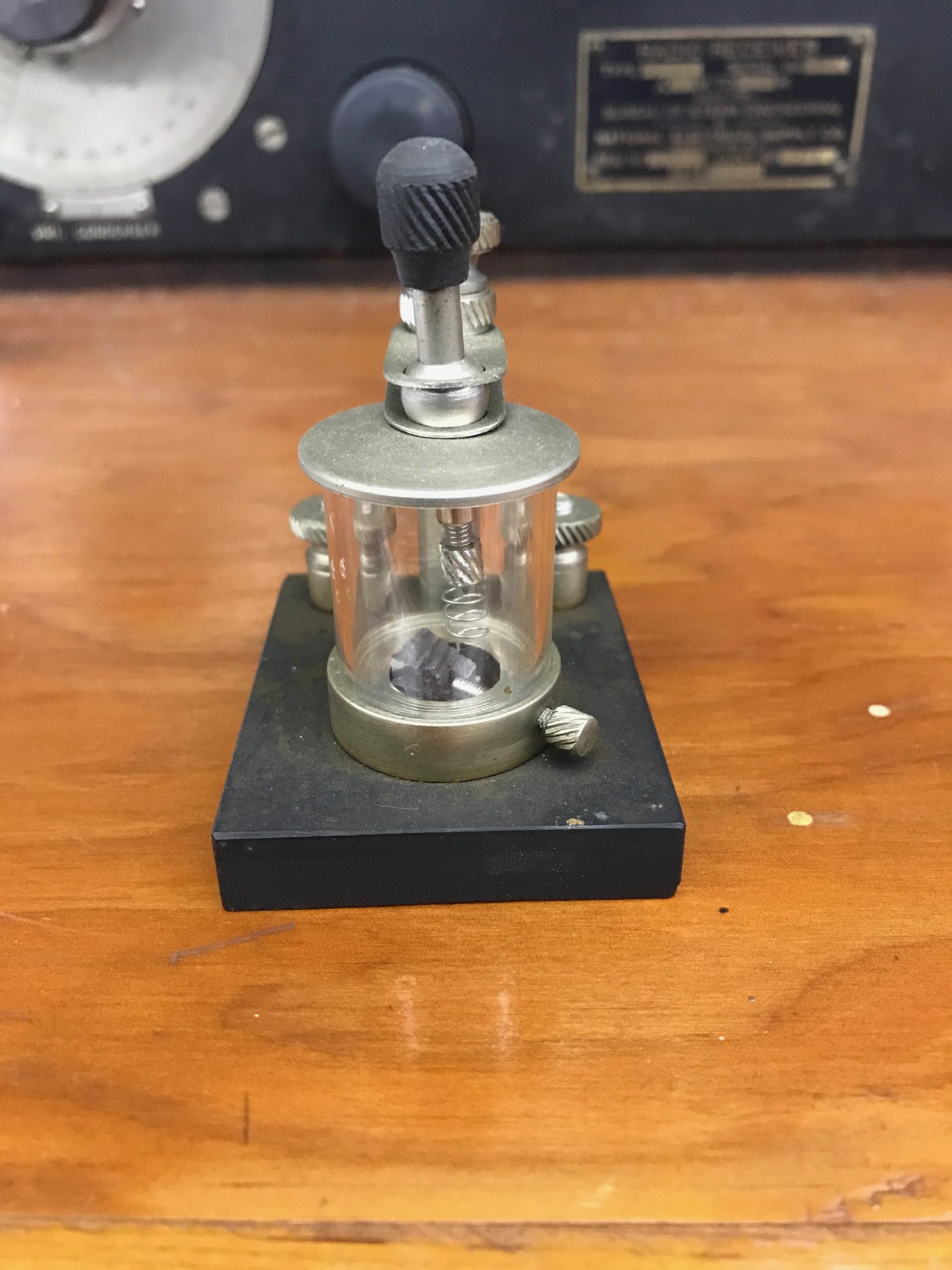 De Forest Model C-100 crystal detector, circa 1915. Replica by Thorn Mayes W6AX, 1978 →
De Forest Model C-100 crystal detector, circa 1915. Replica by Thorn Mayes W6AX, 1978 → Dial Decade Testing Set, E-3105
Drawing of WPRO station and tower
Framed drawing. Sign on building: “WPRO. Cherry & Webb” →
Drawing of WPRO station
Framed drawing. Sign on building: “WPRO FM TV”. This is a different building from that pictured in Drawing of WPRO station and tower. →
E.F. Johnson Viking Ranger Transmitter
E. F. Johnson of Waseca, Minnesota made amateur radio transmitters and receivers in fully wired and kit form. →
E.H. Scott Allwave 23 Imperial
This E.H. Scott Allwave 23 Imperial high-fidelity receiver was made in Chicago, Il in about 1936. →
E.S. Ritchie AM Radio Receiver, Type CBR-4, Series 330
This E.S. Ritchie receiver was manufactured in Brookline, Massachusetts USA, probably in the 1920s →
Eaton Oscillator Type – Triode C
Emerson Portable Radio CVH 10203
Eveready Raytheon Type BH Long Life Rectifier Tube
Faradic Battery
Framed Photos: First Radio Beacon Transmitter built by Robert Kruse, Chesapeake Bay
French field radio
French field radio telegraph in wood case. Labelled “Recepteur Radiotelegraphique No. T. M. 1915” →
Galena Crystal Detector
General Electric motor alternator type CY81A
Motor alternator made for U. S. Army Signal Corps. →
General Electric Receiving Set Type D
General Radio Wave Meter Type 174 B
Geraco Music Master Radio Reproducer
Amplifier in base. Speaker horn of aluminum and wood. →
Giant Reostat
Early Day Wireless →
Gross, Hawk Short Wave Receiver
Hallicrafter Speaker
Hallicrafters High Frequency Communication Receiver SX24, Skyrider Defiant
Hallicrafters High Frequency Communication Receiver SX25, Skyrider Defiant
Hallicrafters S22R Receiver, Skyrider Marine
Hallicrafters Sky Buddy Receiver
Hallicrafters Sky Challenger
Hallicrafters Sky Champion 520R
Hallicrafters Sky Rider 5-10
Hallicrafters Speaker
Hallicrafters Super Skyrider Receiver, Model SX-28A
Hammerland Receiver
Hammerland Super-Pro Receiver
Hammerland Super Pro Receiver BC-779-B Radio Receiver
Harvey Transmitter/Receiver Model 9BG3
Headset CVH-10204
Heathkit Model CR-1 Crystal Radio
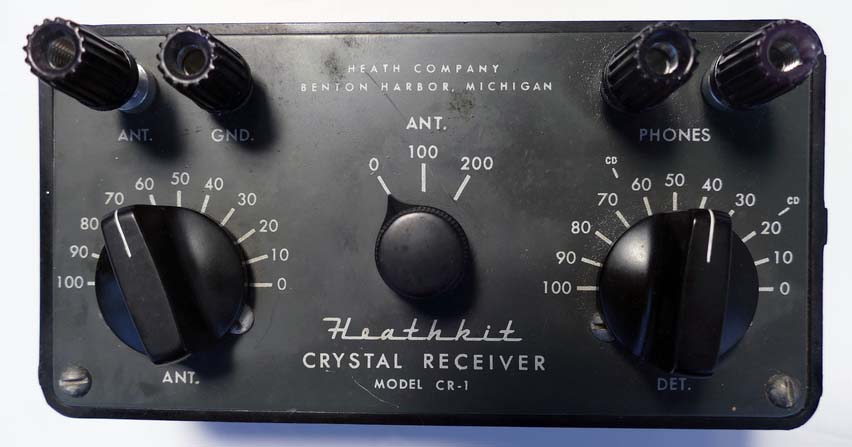 Our Heathkit CR-1 Crystal Receiver from 1958 appears to be complete and ready for testing. As with all crystal radios it requires no direct power supply other than the very small voltage that makes up the incoming radio wave from a local station. →
Our Heathkit CR-1 Crystal Receiver from 1958 appears to be complete and ready for testing. As with all crystal radios it requires no direct power supply other than the very small voltage that makes up the incoming radio wave from a local station. → Heintz and Kaufman Ltd., Gammatron 807
Homemade Crystal Radio in Well-Constructed Oak Box
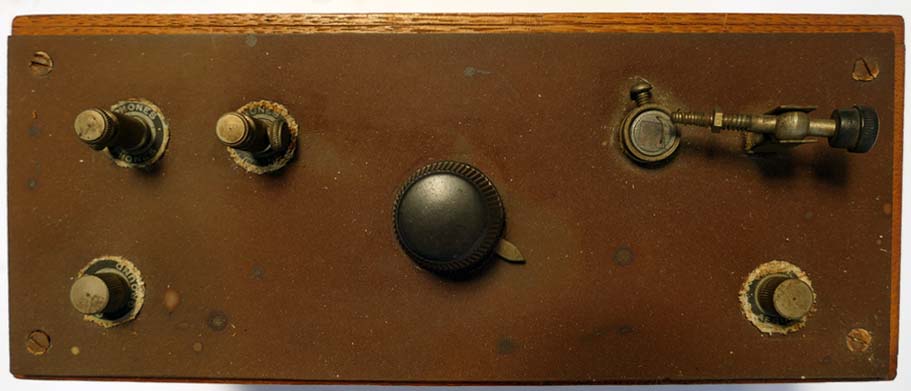 This crystal radio is likely from the early 1920s. It has a composition front panel that is attached to a nicely constructed and finished oak box. The tuning coil and capacitor are inside the box. →
This crystal radio is likely from the early 1920s. It has a composition front panel that is attached to a nicely constructed and finished oak box. The tuning coil and capacitor are inside the box. → Homemade Crystal Radio with Electrical Research Laboratories parts
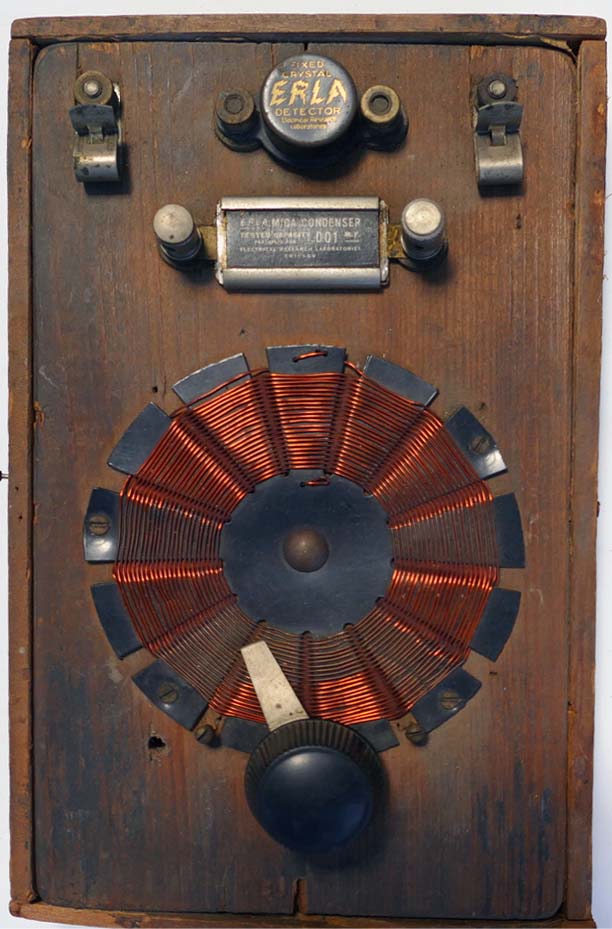 This early crystal radio was likely made in the early to mid 1920s. The builder appears to have used scrap wood, some of which may have been part of a discarded cigar box. →
This early crystal radio was likely made in the early to mid 1920s. The builder appears to have used scrap wood, some of which may have been part of a discarded cigar box. → Hoyt A. C. Volts 0-150 Meter, the 348 Type 531
This A.C. Volt Meter was made by Hoyt Electrical Instrument Works in Penacook, New Hampshire. →
Hoyt Model 100 Tube Tester
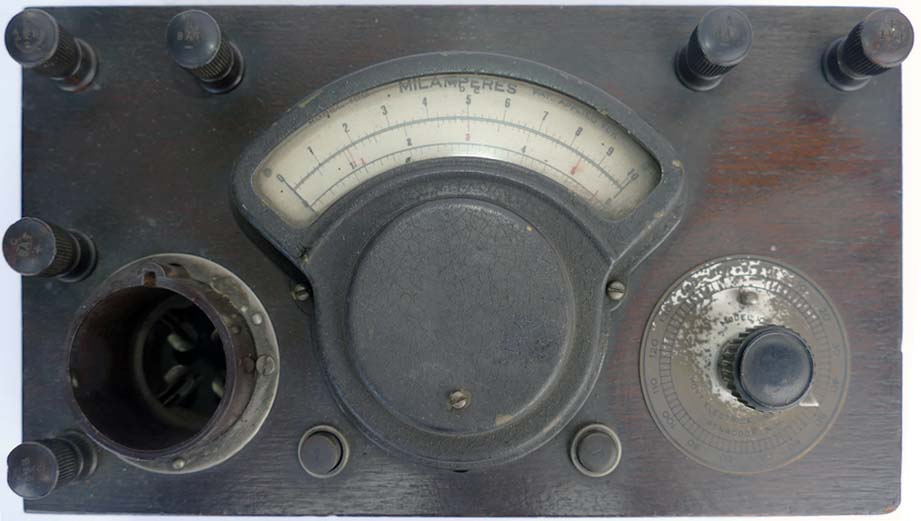 This 1922 tube tester was made by Hoyt Electrical Instrument Works of Penacook, New Hampshire. →
This 1922 tube tester was made by Hoyt Electrical Instrument Works of Penacook, New Hampshire. → International Telegraph Construction Co. Variable Condenser
J. H. Bunnell & Co. telegraph key & sounder
James Millen, 2 tube Receiver
Japanese Army Type 94-3A Transceiver
Type 94 Mark 3A Wireless Set Mark 36 Transmitter Mark 36 Receiver The Type 94-3A transceiver was introduced in 1934 and was used by Japanese Army Division and Regiment stations in the field. The one tube transmitter is CW only using a Hartley oscillator. It has a frequency range of 400 kHz to 5.7 MHz … Continue reading "Japanese Army Type 94-3A Transceiver" →
Japanese Military Radio Collection, Richard A. Day
From the recollections of Richard A. Day: “I landed in Kure (Hiroshima) Japan in Oct. 1945. It was the biggest naval base in Japan close to Hiroshima so I did get to walk on it. Picked up a Morse Key from an untouched warehouse behind a small hill mound. Had it swept and it is … Continue reading "Japanese Military Radio Collection, Richard A. Day" →
Japanese Navy Type 96 “Ku” (sky) Mark 2 Radio Set
Navy Type 96 “Ku” (sky) Mark 2 Radio Set This is a Japanese Navy Aircraft Transceiver capable of voice and CW with a frequency range of 300-500 KHz and 5,000-10,000 KHz. It was made by NIHON MUSEN Co. (Japan Wireless Co.) in July 1941, now known as JRC. This radio set was developed in 1936 … Continue reading "Japanese Navy Type 96 “Ku” (sky) Mark 2 Radio Set" →
Japanese Navy Type 1 ”Ku”(sky) Mark 3 Radio Telephone Set
Navy Type 1 ”Ku”(sky) Mark 3 Radio Telephone Set This radio, serial number 1091, covers the frequency range of 30 to 50 MHz. The transmitter and Receiver frequency is crystal controlled, and the set came with crystals for 5 MHz and 6.88 MHz. It has a cover that snaps over the front and still allows … Continue reading "Japanese Navy Type 1 ”Ku”(sky) Mark 3 Radio Telephone Set" →
Jefferson Tube Rejuvenator
Jefferson Tube Tester
Jewel Radio Test Set
Jewel Radio Test Set
Jewell Radio Set Analyzer Pattern 199
with/ Super Airline CX-201A 62-63" w/Instructions for Servicing Radio Receivers, Jewell Electrical Instrument Co., 1650 Walnut Street Chicago →
John Firth & Co. Electric Plate-Condenser
Kellogg Switchboard & Supply Field telephone model 1917
Made for the U. S. Army Signal Corps. →
Key & sounder
Kolster Decremeter, Bureau of Standards, Type C
Kolster Decremeter, Type D
Leutz Transoceanic Phantom radio receiver, Type 9, Serial Number 425
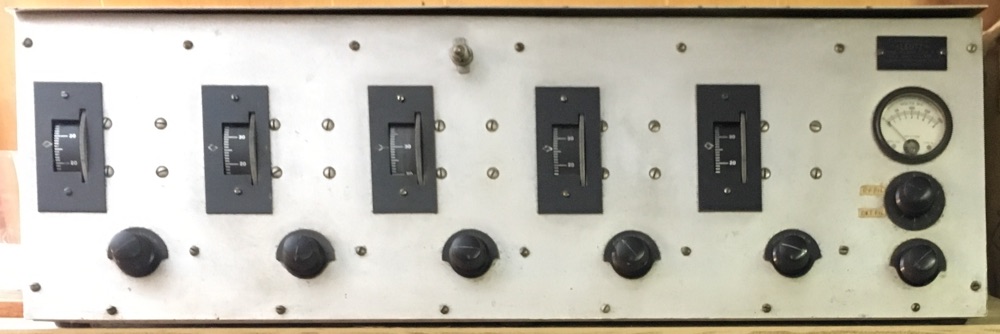 According to Alan Douglas in his book Radio Manufacturers of the 1920s, Charles Leutz began his own business, Experimenters Information Service, in cooperation with Claude Golden, in 1921. They sold blueprints for superheterodyne radios designed by Leutz. They eventually began the Golden-Leutz Co. and sold part kits with the plans. By 1924 RCA had successfully sued to prevent Leutz from making superheterodyne kits. →
According to Alan Douglas in his book Radio Manufacturers of the 1920s, Charles Leutz began his own business, Experimenters Information Service, in cooperation with Claude Golden, in 1921. They sold blueprints for superheterodyne radios designed by Leutz. They eventually began the Golden-Leutz Co. and sold part kits with the plans. By 1924 RCA had successfully sued to prevent Leutz from making superheterodyne kits. → Little Rody 2 Meter Transceiver
Long Wave Loading Unit Type IP 503
Mackay Radio & Telegraph Co., 123-B
Magnavox R3 Horn Speaker
This 1922 Magnavox R3 14-inch horn speaker will eventually be on display at the New England Wireless and Steam Museum. Currently it awaits reconditioning of the companion radio that we have chosen to pair it with, the Grebe Synchrophase MU1. The R3 speaker was introduced in 1922 at a price of $45 and by 1923 it was reduced to $35. They sold very well! →
Marconi Contact Switch
Marconi Model CM-294 Shortwave Receiver
Marconi Type 106-D Radio Receiver
Marconi Valve (Tube) P240
Marconi Valve Tuner No. 7054
Medium Wave Receiver Type SE 142C ©
Melo-Heald “Eleven” radio receiver
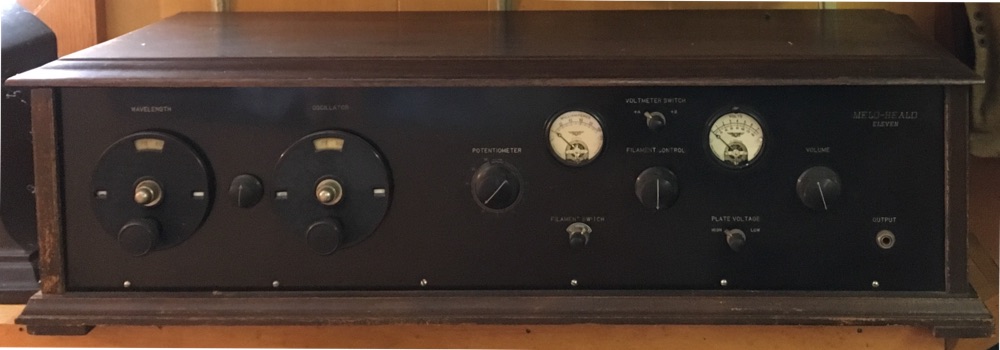 Melo-Heald Eleven superheterodyne receiver in wood case. →
Melo-Heald Eleven superheterodyne receiver in wood case. → Metro Jr. Crystal Radio
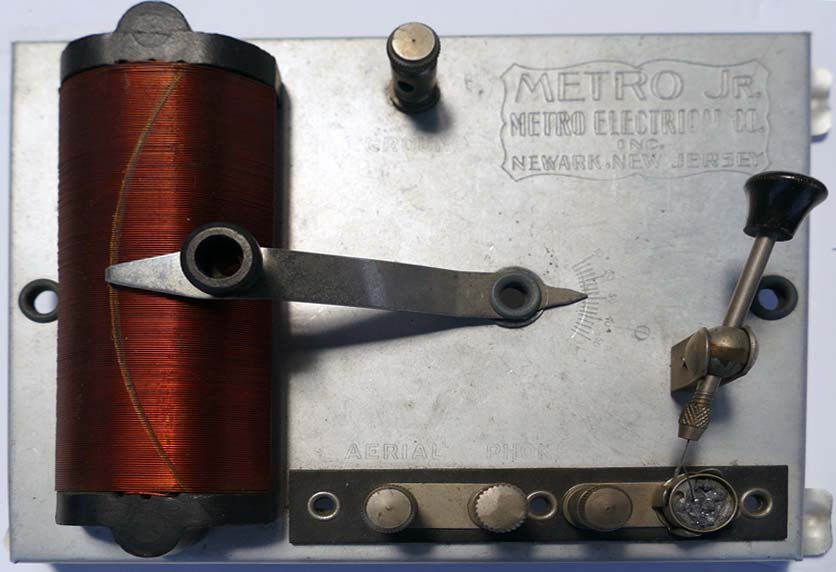 The Metro Jr. crystal radio was made by Metro Electrical Company, Inc. of Newark, NJ. It was produced in 1923 and 1924. This is a simple radio that is designed to receive local AM radio stations in the broadcast band. The radio was also called the Metropolitan. This radio is designed to be tacked down … Continue reading "Metro Jr. Crystal Radio" →
The Metro Jr. crystal radio was made by Metro Electrical Company, Inc. of Newark, NJ. It was produced in 1923 and 1924. This is a simple radio that is designed to receive local AM radio stations in the broadcast band. The radio was also called the Metropolitan. This radio is designed to be tacked down … Continue reading "Metro Jr. Crystal Radio" → Minsk Radio Plant, Horizon 219 Receiver
This portable radio, model Horizon-219, was manufactured by the Minsk radio plant some time after 1979. It can be tuned in several frequency ranges; long wave, medium wave, short wave with 5 separate sub-ranges, and ultra-short wave which corresponds to FM radio. There is a telescopic antenna for receiving short and ultra-short radio waves and a … Continue reading "Minsk Radio Plant, Horizon 219 Receiver" →
Model RBG-2, Radio Receiving Equipment
Model S-30, Radio Compass
N.R.I Tape No 7 / N.R.I Tape No 8
N.R.I Tape No 3 / N.R.I Tape No 4
National 4 Tube Thrill Box SW-4
National Company
National Company Inc. Oscilloscope Type CPN
National Company MB-20 Receiver, The Velvetone
National Electric Supply Co. wavemeter type SCR98
Wavemeter made for the U. S. Army Signal Corps. →
National NC HRO “Sixty” Receiver w/Plugin Coil Set
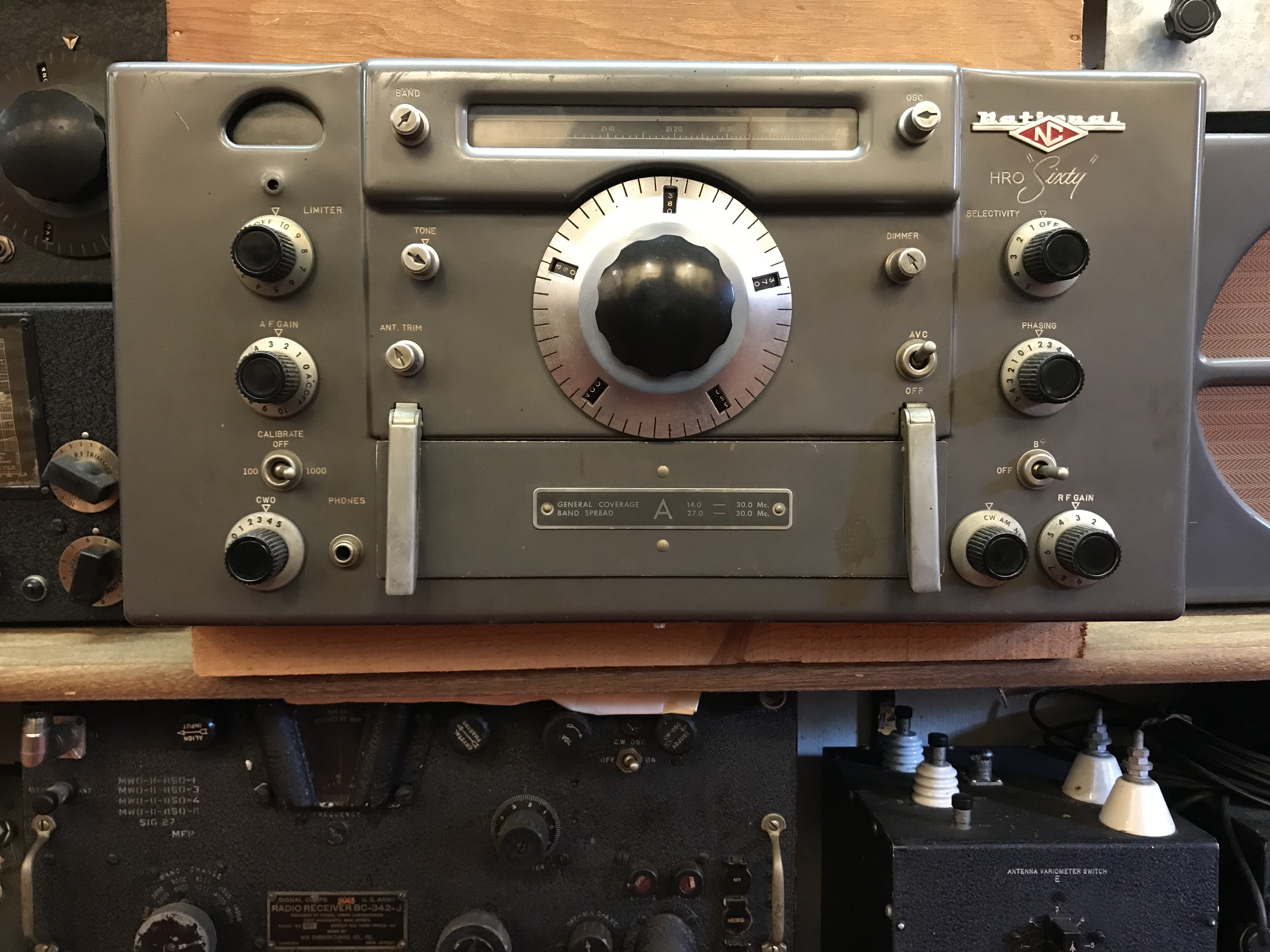 The HRO-60 is one of the most iconic shortwave receivers in radio history. Although it was first made back in 1952 it is still sought after by modern radio collectors and listeners.
The HRO-60 was manufactured by National Radio Company of Malden, Massachusetts (moving to Melrose, MA in 1964). The last HRO-60’s were produced in 1962. →
The HRO-60 is one of the most iconic shortwave receivers in radio history. Although it was first made back in 1952 it is still sought after by modern radio collectors and listeners.
The HRO-60 was manufactured by National Radio Company of Malden, Massachusetts (moving to Melrose, MA in 1964). The last HRO-60’s were produced in 1962. → National Rack Mount Speaker
National RAS-3 Rack Mount Coil Unit w/Type CNA-47156 Coil Set 1
National RAS-3 Rack Mount Coil Unit w/Type CNA-47157 Coil Set 2
National RAS-3 Rack Mount Coil Unit w/Type CNA-47158 Coil Set 3
National RAS-3 Rack Mount Coil Unit w/Type CNA-47159 Coil Set 4
National RAS-3 Rack Mount Coil Unit w/Type CNA-47160 Coil Set 5
National RAS-3 Rack Mount Coil Unit w/Type CNA-47161 Coil Set 6
National Receiver
National Receiver
National Receiver
National Spare Plugin Coils Set
National Speaker
National Speaker
National Type AGF Number C35 Receiver
Naval Compass Station NBS at Surfside Nantucket ~1918 – 3 Photos
Japanese Navy Type 3 Mark 1 Model 3 Radar Receiver
Japanese Navy Type 3 Mark 1 Model 3 Radar Receiver This VHF receiver is part of the Japanese Navy Type 3 Mark 1 Model 3 Radar Set (No.13 Radar Set), and was made by the Navy YOKOSUKA arsenal in September 1944. This set is a semi-fixed anti-aircraft surveillance radar for ground troops, introduced in 1943. … Continue reading "Japanese Navy Type 3 Mark 1 Model 3 Radar Receiver" →
Navy Two Step Amplifier, Type SE1000
NC Receiver NC-100
NC Speaker
NEARC Lifetime Member Plaque for Robert Merriam
Oceanic and Oriental Navigation Company Receiver “Golden Chest” IP-500
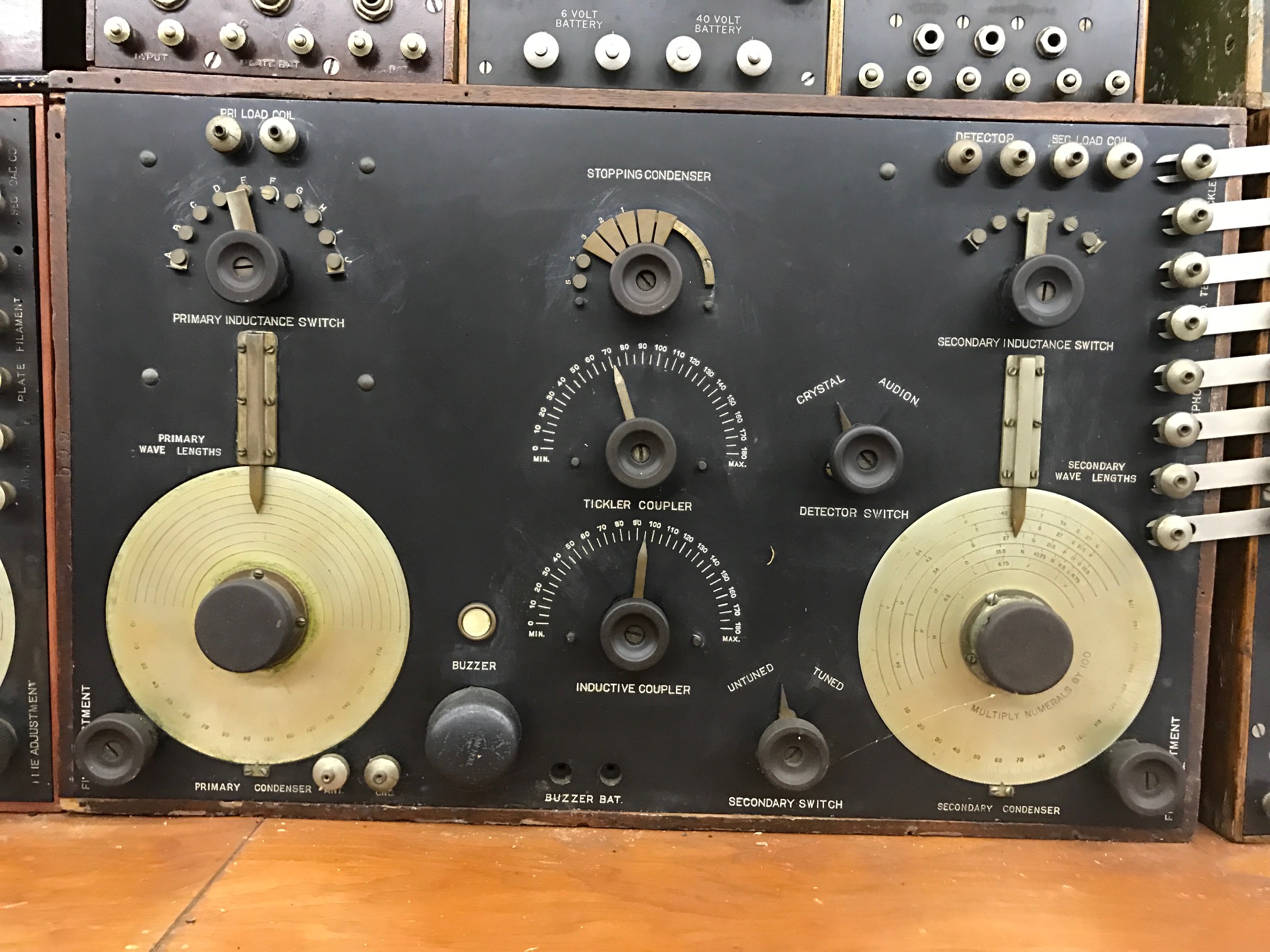 Operators:
John L Vincent Op. August 28, 1919
Norman F Moore, Op. 21-22
M. A. Hauge, Op. 27
C. Dunn, p. 29 & 30 →
Operators:
John L Vincent Op. August 28, 1919
Norman F Moore, Op. 21-22
M. A. Hauge, Op. 27
C. Dunn, p. 29 & 30 → Omnigraph Morse code trainer
Spring-driven Morse code trainer mounted on wood base, with 10 code disks. →
Omnigraph Morse code trainer
Spring-driven Morse code trainer mounted on wood base, with 10 code disks. →
Pamplet: The Velvetone MB 29
Paragon DA-2 Detector Amplifier
Paragon Regenerative Receiver Type RA-10
Paragon RA-6 receiver
Paragon Radio Telephone 2-5-U
Pattern 560 Service Test Oscillator
Philco 38-1-116XX Radio and Phonograph
This 1938 system is a Philco 38-116 radio chassis and a Capeheart turntable in a Radiobar cabinet. →
Philco Model 39-25T Tabletop Radio
The Model 39-25T is Philco's first tabletop radio to feature a slanted control panel. →
Philmore Little Wonder Crystal Radio
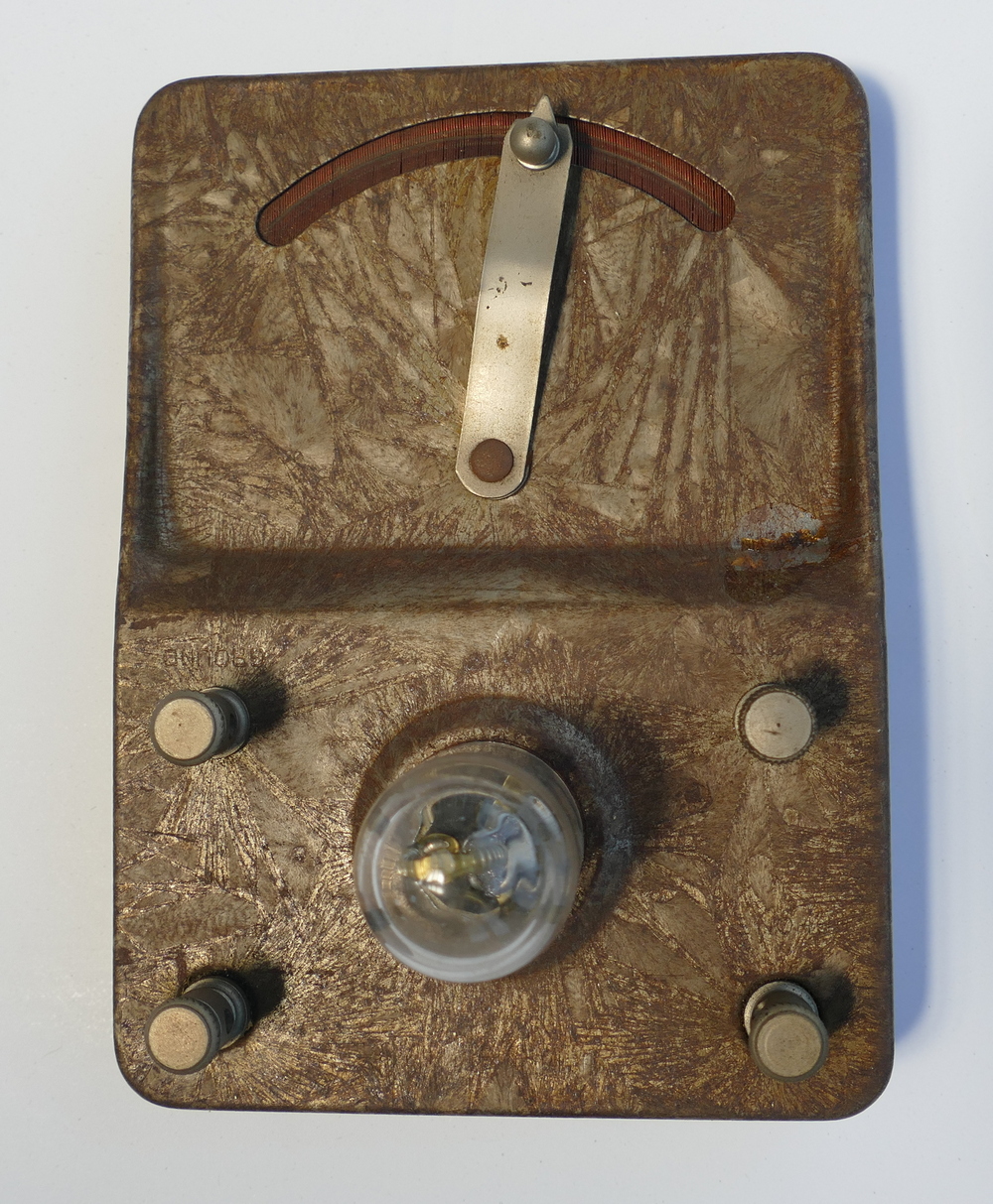 The Philmore Little Wonder Crystal Radio is noted for the glass cover over its catwhisker to prevent accidently changing the adjustment. It is most likely an early version made in the 1920s. →
The Philmore Little Wonder Crystal Radio is noted for the glass cover over its catwhisker to prevent accidently changing the adjustment. It is most likely an early version made in the 1920s. → Photo: Gerry Travis and Bill Halligan
Photo in Frame Selwyn N Blake, K1CPW – Founding Director
Photograph of Angelo Cafaro repairing Navy radar
Framed black and white photograph of Angelo Cafaro. Also an unframed inkjet color print of another photo of Cafaro. →
Pilot Super Wasp Receiver
Pilot Wasp Receiver 3-201A
Pocket ammeter
Power Coupler
Precision Condenser
At the museum: Massie Station Maker: General Radio Co. Place: Cambridge, Mass U.S.A Date: Donor: Specifications [delta]C=1000 M.M.F. Type 22-M Serial No. 1435 →
Push to Talk Hand Set Type CW920
R-1/ARR-1 Antenna Box
Radi Receiver-Transmitter, PT-159B/URC-4
Radio Club of America Certificate Given to Robert E Merriam
Radio Compass Receiver
Radio Frequency Ammeter Type CT1477
Radio Manufacturing Engineers, HF10-20, Communication Receiver
Radio Manufacturing Engineers, Model RME-69 Communication Receiver
Radio Manufacturing Engineers, Model RMW-45, Communication Receiver
Radio Manufacturing Engineers RME-45 Communications Receiver
 Radio Manufacturing Engineers Company began business in 1932 in Peoria, IL. By 1953 they had merged with Electro-Voice, the famous manufacturer of microphones. This particular radio, the RME-45 from 1946 was a very capable unit. The example in our collection was purchased new in 1946 by New England Wireless and Steam Museum founder Robert Merriam. →
Radio Manufacturing Engineers Company began business in 1932 in Peoria, IL. By 1953 they had merged with Electro-Voice, the famous manufacturer of microphones. This particular radio, the RME-45 from 1946 was a very capable unit. The example in our collection was purchased new in 1946 by New England Wireless and Steam Museum founder Robert Merriam. → Radio Manufacturing Engineers, Speaker
Radio Mfg Engineering Inc Receiver DB-22A
Radio Mfg. Engineering Inc Tuner
Radio Mfg Inc. Receiver ME-14
Radio Phone Diagram
Radio Receiver BC-739-A
Radio Receiver, Part of Receiver and Transmitter BC654-A
Radio receiver & transmitter BC-322
Radio Receiver Type 501A
Patented
Jan 15, 1907 Oct 6, 1914 July 3, 1917
Feb 18, 1908 June 1 1915 Sept 11, 1917
Mar 14 1911 Jan 23 1917 Oct 22, 1918
Jan 14, 1913 Dec 23, 1919
Sept 6, 1914 Aug 22, 1922
Patents Pending →
Radio Receiver Type 501A
Radio Receiver Type CN-240
Radio Receiver Type I. P. 501 Serial #EAA274
Radio Receiving Set Box. Type BC-14A
Made for the U. S. Army Signal Corps. →
Radio Telegraph Co.
Radio Telegraph Transmitter, Model ET 8003
Radio Telegraph Transmitter Model ET-8004
Radio Wavemeter Made, SE965, for Bureau Steam Eng’R’G’
w/Loop Antenna
w/ 3 Coils, Meter 89 Coil 1, Meter 89, Coil 3, Meter 47, Coil 3 →
Radiotron UV-863 25061
Raytheon RK38
RCA Model 100-A loudspeaker
RCA Model AVR-20-A aircraft receiver
RCA Model AVT-112-A aircraft transmitter
Similar artifact at the Smithsonian Institution Air & Space Museum → →
RCA Radiotron 891R
Tube with vanes for air-cooling. →
Receiver Amplifier Type IP501A, Serial No. 331 EMM
Patented Jan. 15, 1907 Feb. 18, 1908 Mar. 14, 1911 Jan. 14, 1913 Sept. 3, 1914 Oct. 6, 1914 June 1, 1915 Jan. 28, 1917 July. 8. 1917 Sept. 17, 1917 Oct. 22, 1918 Dec. 23, 1919 Aug. 22, 1922 Patents Pending Property of Radio Corporation of America Not Licensed for use by Ornts. →
REL 5 Meter Receiver -296-
Remler Infradyne
The Infradyne is a variation of a Superheterodyne and was designed by E.M. Sargent →
Replica DeForest RJ-4 Detector
RF Antenna Current Meter, Model 400
WEM/WSO 200KW, installed in Marion MA 1919, Therm-Ammeter, No. 4599 →
Roller-Smith Co. Ohmeter Type Com
“S.O.S.” from a painting by Fredrick Roe (1864-1947)
Siemens Luftwaffe K32 GWB radio receiver
Signal Corps CASE CS-137
Signal Corps Dynamotor Unit BD-77-KM
Signal Corps Radio Receiver and Transmitter BC-1000-B
Signal Corps Radio Receiver and Transmitter BC-659-J
Signal Corps Radio Receiver Type BC-144 U.S. Army
Signal Corps. Radio Transmitter
Signal Corps Radio US Army Transm’itter and Receiver, BC-054-A
Signal Corps, US Army Antenna Tuning Unit BC-306-A
Signal Corps. US Army Radio Receiver, BC-342-H
Signal Corps. US Army Radio Receiver, BC-348-J
Signal Corps, US Army Radio Receiver Transmitter BC-148
Signal Corps, US Army Radio Transmitter, BC-AN-430
Signal Corps US Army Radio Tuner Type BC-138
Use with Radio and Tel & Tel Set Type SCR-132 →
Signal Corps, US Army Transmitter Tuning Unit TU-9-B
Signal Corps, US Army Transmitter Tuning Unit TU-10-B
Signal Corps, US Army Tuning Unit BC-746 B CH5
Signal Corps US Army Wavemeter Type BC-DA-153
Signal Corps Wireless Set No 19 MK II Aerial Variometer
Signal flag kit
U. S. Army signal flag kit in canvas carrying case. →
Silver Marshall Inc. BC Receiver
Single Signal Super, RME-9D
Spare Valve Case
Sterling Type R-411 Home Tube Tester
with/ Super Airline GX-201A 62-63" →
Stromberg-Carlson portable wireless set
Made for the U. S. Army Signal Corps. In leather case, with key, sounder and space for batteries. →
Super Skyrider Receiver
The Nacometer [Automatic Code Transmitter]
The Omnigraph
The Penta Laboratories Inc. PL-8438
Thrust Bearing from Alex Anderson Alternator at Marion Mass
Transmitter Receiver Type CW925
Short Range Radio Telephoning Set for 32 Volt DC supply consisting of: →
Transport Crate for Japanese Navy Type TM Short Wave Mobil Wireless Set Improvement 4 Battery Charger
This transport case held the battery charger for a Japanese Navy Type TM Short Wave Mobil Wireless Set Improvement 4. →
Tuning Capacitor
Tuning Unit Type TU-53, 8.0-12.0 MC
Two Stage Amplifier Type WI-125A
Two Step Amplifier Type SE1000
Two Step Amplifier, Type TRIODE – B
Type CR1-43044, Transmitter-Receiver
U. S. Coast Guard, Pre Selector, Type MR-148
U.S. Navy Portable Wave Meter
Ultimate Transmitter Company 73
Universal Sterling Tube Tester R-408
Unknown 2 Tube Receiver (Home Brew)
Unknown 2 Tube Receiver (Home Brew)
Unknown Meter, Model 301
Unknown Photo
Unknown Receiver
Unknown Receiver
Unknown Variocoupler
Unknown Walkie-Talkie
Unknown Walkie-Talkie
US Army Signal Corps Transmitting Tuning Radio Transmitter
US Army Signal Corps Transmitting Tuning Unit
US Army Signal, Engineering Laboratories
Variable Air Condensor
Veifa-Werke-Frankfurt A/M Rontgenzwecke
Marconi W. T. Sets field radio
In canvas case with carrying strap. With telephone-style handset. →
Marconi W. T. Sets Forward Spark Mk. II transmitter
Marconi W. T. Sets Trench C. W. Selector
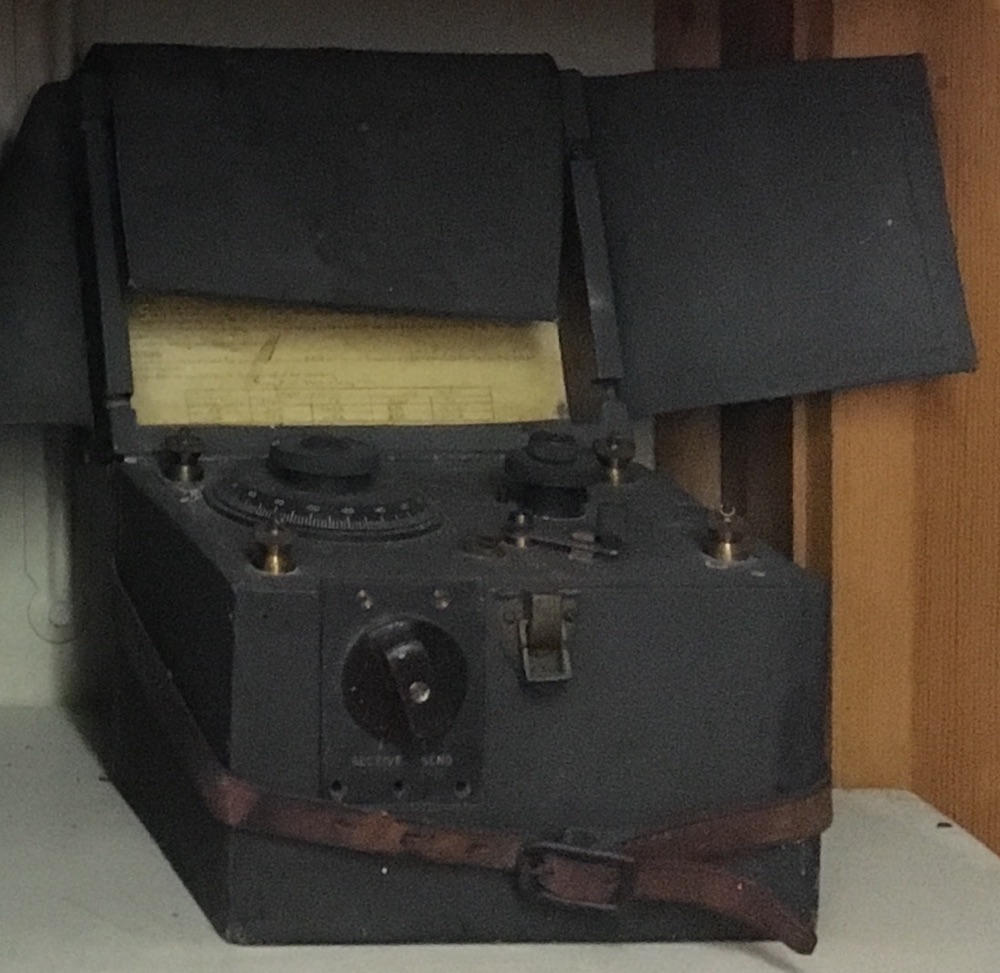 Marked: “M. W. T. Co. Ltd.” →
Marked: “M. W. T. Co. Ltd.” → National Electrical Supply Wavemeter Type SCR 61
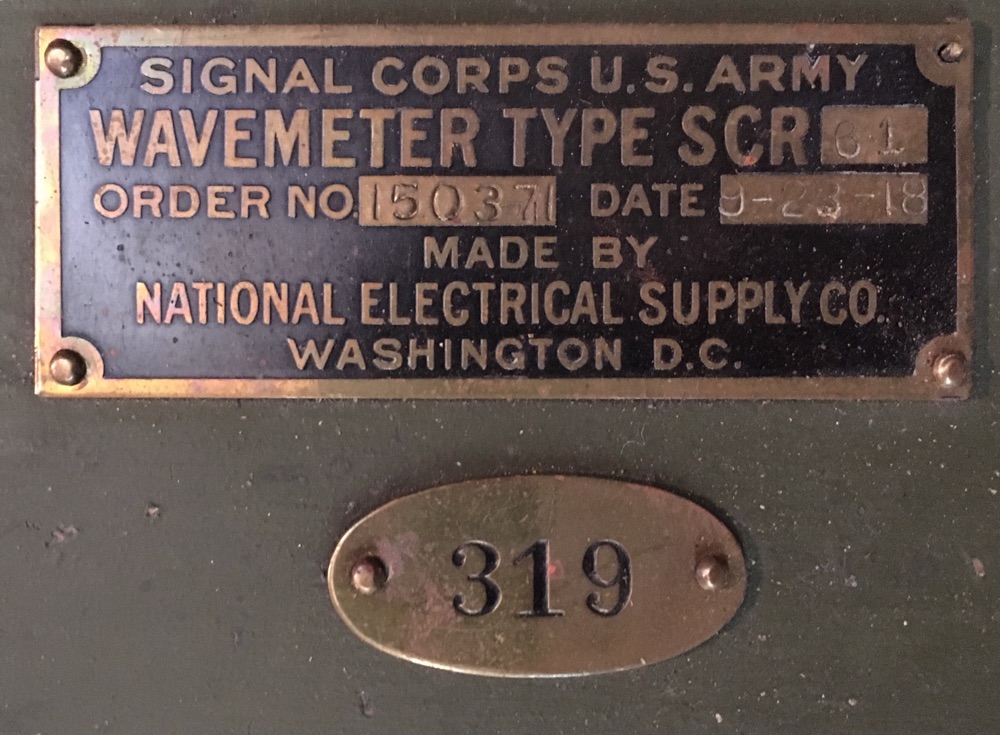 Made for the U. S. Army Signal Corps. →
Made for the U. S. Army Signal Corps. → Western Electric Type Number CW-924 Transmitter-Receiver
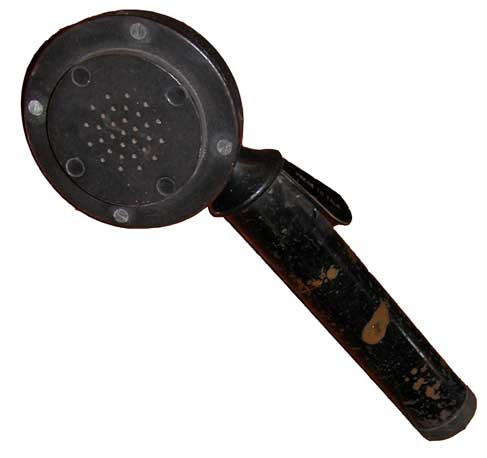 This CW-924 transmitter-receiver was used during WW I. It is the world's first push-to-talk radio. →
This CW-924 transmitter-receiver was used during WW I. It is the world's first push-to-talk radio. → Western Electric Airplane Interphone type S.C.R. 57
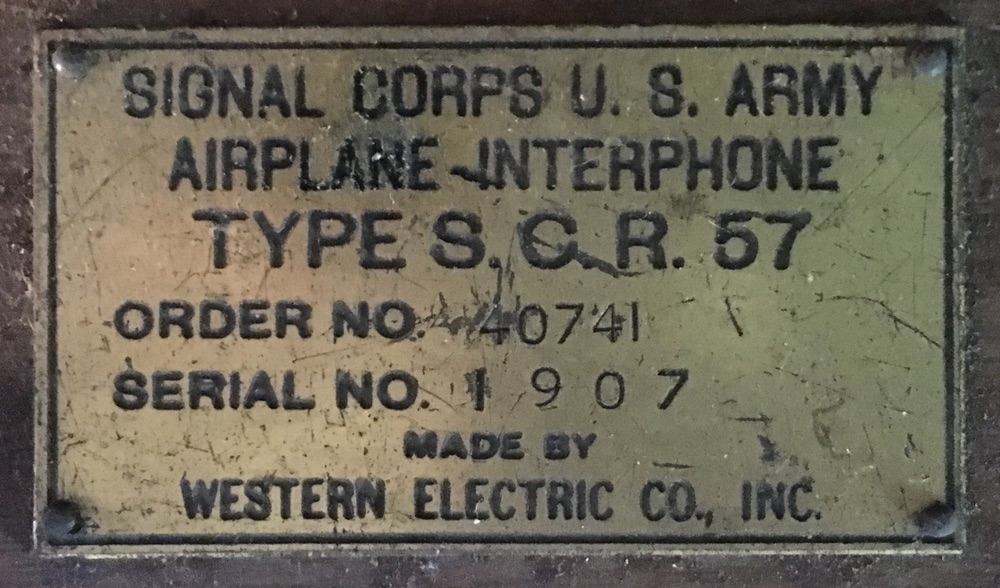 Wired system for communicating between airplane pilot and 'observer' with connection for wireless receiver/transmitter. In box with cables and connection diagrams. Made for U. S. Army Signal Corps. →
Wired system for communicating between airplane pilot and 'observer' with connection for wireless receiver/transmitter. In box with cables and connection diagrams. Made for U. S. Army Signal Corps. → Western Electric transmitter/receiver
Wood case, with key and headphone. →
Westinghouse J-38 knee-mounted key
For use by airplane pilot. →
Westinghouse airplane wing-mounted spark generator
Weston AC Voltmeter
Weston Direct Current Voltmeter
Weston Meter Model 301
Weston Model 537 No. 1648 Radio Set Tester
With/ The Instructions for use →
Weston Model 590 Oscillator
Weston Tester
Weston Voltmeter, Model 301 (Radio Tester), V.J.M Co.
Wheel with Multiple Contacts
White Star Line Titanic Poster
Wireless Sets No. 19 Variable Variometer
Wireless Test Equipment
The New England Wireless and Steam Museum has a large collection of test equipment spanning from the late 1800s through the 1950s. You can click on any listed equipment on the right side of this page for more details. →
Zenith 10-H-571, the “Spinet”
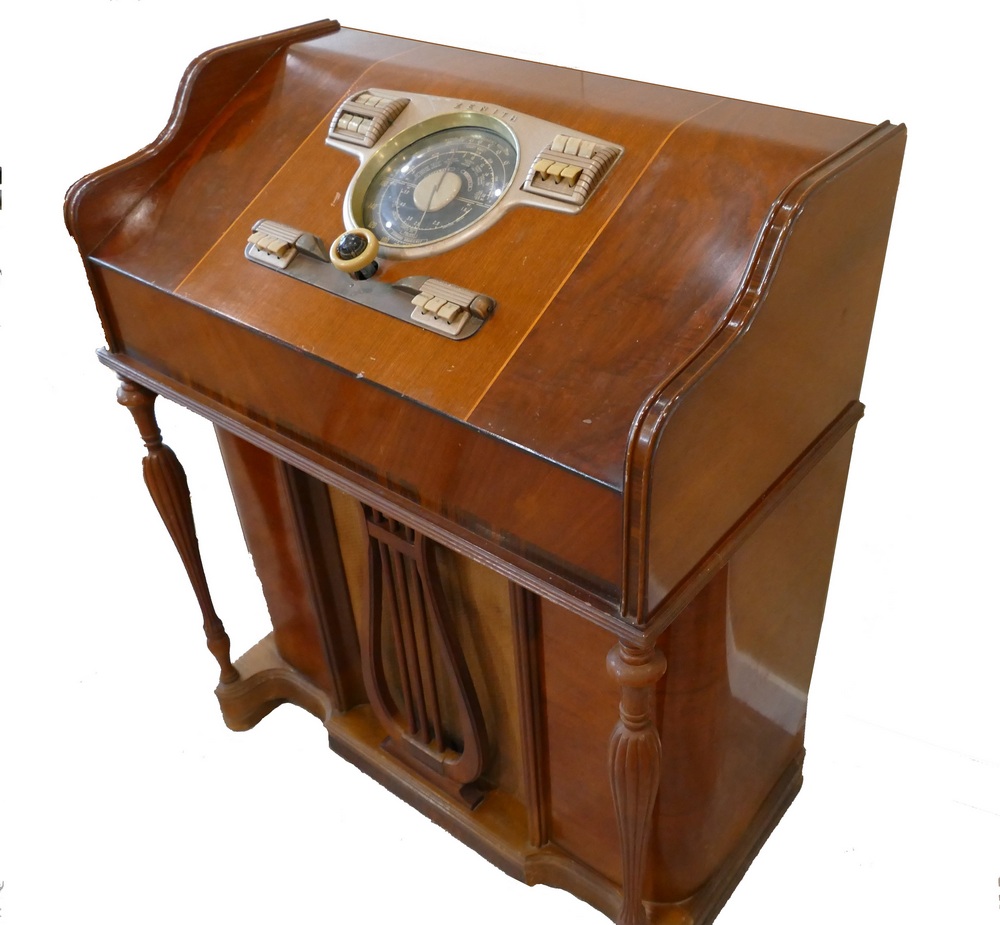 This 1941 Zenith radio received broadcast AM, FM, and two shortwave bands and was housed in an attractive spinet cabinet. →
This 1941 Zenith radio received broadcast AM, FM, and two shortwave bands and was housed in an attractive spinet cabinet. → 